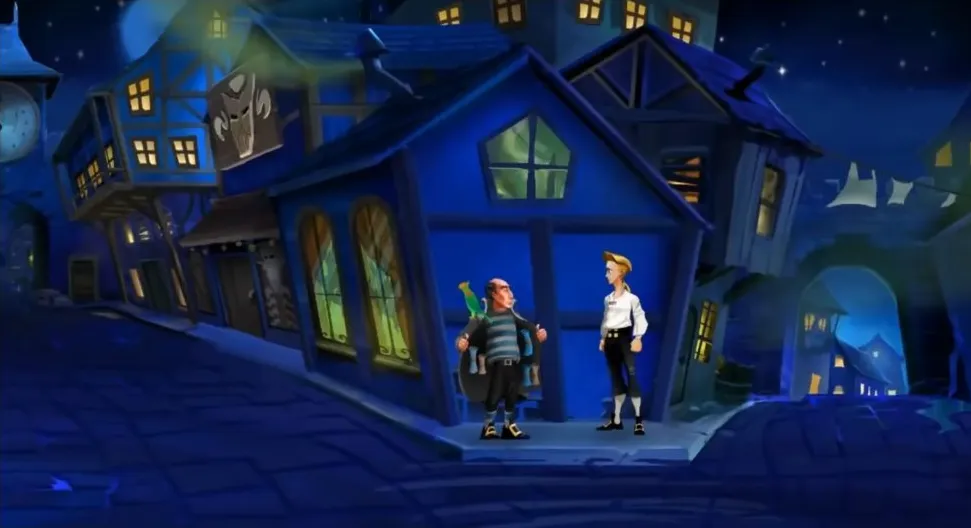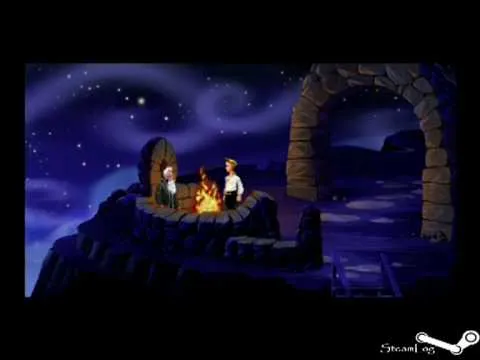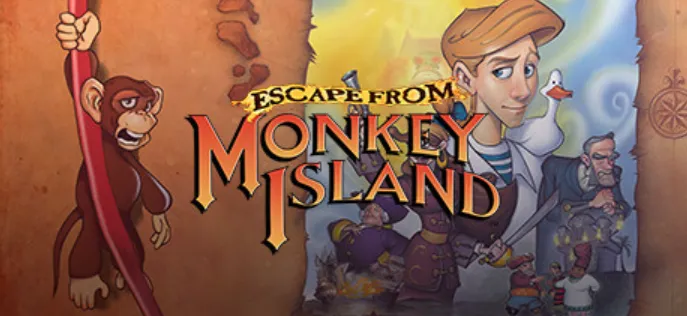
Monkey Island is a series of graphic adventure games. The first four games in the series were produced and published by LucasArts, formerly known as Lucasfilm Games. The fifth installment in the franchise was developed by Telltale Games in collaboration with LucasArts. The games follow the adventures - or rather misadventures - of Guybrush Threepwood as he struggles to become the most famous pirate in the Caribbean, defeat the plans of the evil undead pirate LeChuck, and win the heart of Elaine Marley. The plot of each game generally involves the mysterious Monkey Island and its impenetrable secrets.
The first game in the series was created between Ron Gilbert, Tim Schafer, and Dave Grossman. Gilbert worked the first two games before leaving LucasArts. Grossman and Schafer, who also worked on the first two games, would enjoy success in other games before they both left the company. And the third and fourth games were created without the direct involvement of the original staff. Dave Grossman was the project leader for the fifth game in the series and Ron Gilbert was involved with the first game design. Much of the music for the games is composed by Michael Land. The score consists primarily of reggae, Caribbean, and dub-inspired music.
Adventures are played from a third person perspective. The first three use an evolution of the SCUMM engine or language, which was used in 1987 for Maniac Mansion. In the first two through a point and click interface, the player guides the protagonist Guybrush Threepwood through the game world and interacts with the environment by combining twelve verbal commands with characters and objects. While chatting with other characters, the player can choose from the discussion topics that are listed in a dialogue tree. The action in the game is frequently interrupted by scenes, just like other LucasArts adventure games. The third iteration uses an evolved SCUMM that changes the menu of verbal commands to a coin showing possible actions. The fourth installment changed to the GrimE engine that was used for Grim Fandango and was already an engine with 3D characters and objects and pre-rendered backgrounds. In this case the actions are prepared and there is greater control of the movements of the characters. The TellTale episode delivery, although it used a different 3D engine, mimicked GrimE and was played with a mouse or keyboard.

HUMOR AND EASTER EGGS
The series is known for its humor and easy and intuitive gameplay for the novice player. The main character is not exposed to continuous deaths, and the game is not based on a dichotomy of victory or defeat. The Monkey Island series features a design philosophy that makes the death of the player character nearly impossible. The series also tends to break the fourth wall, as several of the characters acknowledge that they are in a video game. This friendly approach was unusual at the time the first game was released in 1990. LucasArts preferred an open story format for other humor-oriented adventure games such as Sam & Max Hit the Road -1993- and The Day of the Tentacle -1993-. After Monkey Island 2: LeChuck’s Revenge in 1991, the series went on hiatus until 1997, when it resumed with The Curse of Monkey Island. After the fourth entry, Escape from Monkey Island, the franchise was discontinued again, although it resurfaced in an episode format in Tales of Monkey Island by Telltale Games in early 2009.
Each of the games takes place on fictional islands in the Caribbean around the Golden Age of Piracy. The islands are teeming with pirates dressed in outfits that seem to come from movies and comics rather than reality history, and there are many deliberate anachronisms and references to modern popular culture.
The main setting for the Monkey Island games is the "Area of the Three Islands", a fictional archipelago in the Caribbean. Since the first game in the series, The Secret of Monkey Island, three of the games have visited the island of Monkey Island, while all have introduced their own set of islands to explore. Monkey Island 2: LeChuck’s Revenge introduces four new islands, but doesn't return to Monkey Island until the final scene. The Curse of Monkey Island features three, and Escape from Monkey Island, which revisits some of the older islands, also features three new islands. As such, the area of the three islands actually comprises a total of 13 visitable islands. Tales of Monkey Island takes place in a new area of the Caribbean called "Gulf of Melange."
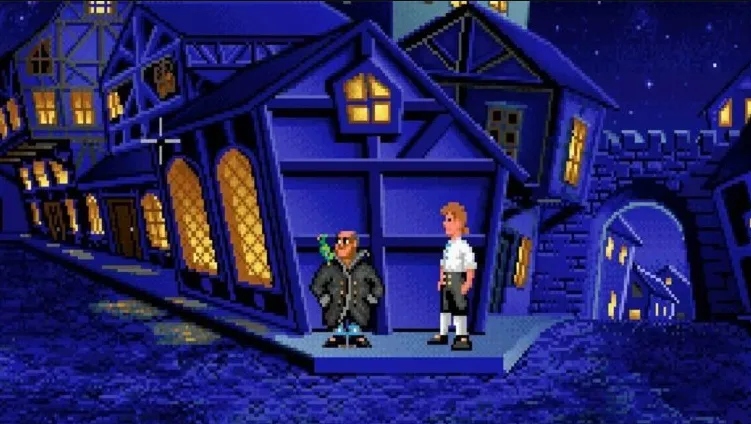
The series is full of parodies, inside jokes, humorous references, and Easter eggs. There are phrases that are already part of the cultural heritage of the video game. Lines like "Look behind you, a three-headed monkey!"; "My name is Guybrush Threepwood and I am a powerful pirate" or "I once had a dog smarter than you. He will have taught you everything you know.
The first installment also teased rival company Sierra's endgame screens. When Guybrush falls off a cliff, a Game Over window appears, but then Guybrush returns to the top of the cliff, explaining that he landed on a "rubber tree." At another point, when Guybrush remains underwater for more than ten minutes, he dies and an end-of-game dialog appears identical to the one in Sierra's King's Quest series, giving the player the option to restore a saved game and jokingly says, "I hope you saved the game!"
Each game contains a map puzzle, in which Guybrush must use an unconventional map to find his way. The first game features a set of dance instructions that point the way through the dense forest of Mêlée Island to find the island's legendary treasure. In the second game, Guybrush must use a song from a dream sequence to find his way through LeChuck's dungeon. The third game is the other way around, as the instructions the player receives are traditional instructions and must be used on a theater light board. The fourth game has a set of directions based on time, and the fifth based on the sounds of animals and the direction of the wind and finally a map to obtain one of the necessary elements for «The Feast of the Senses».

Another common item is a sequence where players must gather ingredients to create an item. Then later in the game the player has to create the item again, but this time with makeshift materials. In the first installment Guybrush must prepare a voodoo mix but, lacking ingredients, must improvise with the contents of his inventory, which leads to fun word games. In Monkey Island 2, at two points in the game, Guybrush has to create a voodoo doll, one of Largo LaGrande with legitimate ingredients and one of LeChuck with improvised ingredients. The same goes for the hangover medicine in 'Curse' and the Last Insult in 'Escape'. 'Tales' starts off when Guybrush has to get some sparkling root beer, then he drops it and he has to make some sparkling root grog. Later, 'Tales' requires Guybrush to organize a 'feast of the senses' to increase the size of La Esponja Grande, and then trace an inverted recipe for the 'diet of the senses'.

GUYBRUSH THREEPWOOD
The origin of the name comes from the tool used by the artists to create the character. The file was simply named 'guy.bbp'. Graphic artist Steve Purcell added "brush" to the file name. The developers started referring to the character as ‘guy’ and it stayed that way. The surname 'Threepwood' was decided in an internal company competition. Throughout the adventures we can find out personal data such as age, year of birth or weight. Each installment of the saga revolves around three main characters: Guybrush Threepwood; his beloved Elaine Marley; and the villain, the ghost pirate LeChuck.
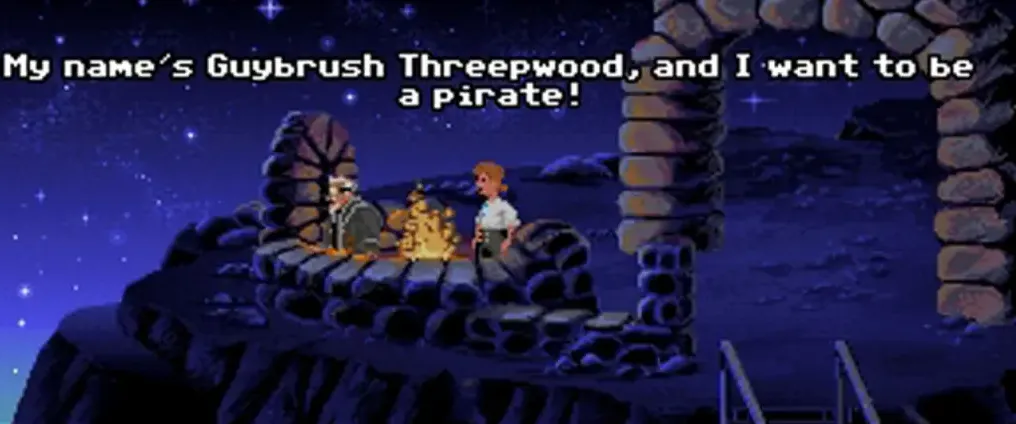

THE SECRET OF MONKEY ISLAND
The series debuted in 1990 on the Amiga, MS-DOS, Atari ST, and Macintosh platforms. The game was versioned to FM Towns and Mega-CD in 1993. A remastered version with updated graphics and new voice-overs was released for PlayStation Network, Windows PC, Xbox Live Arcade, and OS X. An iPhone version was also released on the 23rd. July 2009.
The game begins with the main character Guybrush Threepwood saying "I want to be a pirate!" To do so, he must prove himself to three old pirate captains. During the pirate trials, he meets the beautiful governor Elaine Marley, with whom he falls in love, unaware that the ghost pirate LeChuck also has his eyes on her. When Elaine is kidnapped, Guybrush acquires the crew and ship to track down LeChuck, defeat him, and rescue his love.
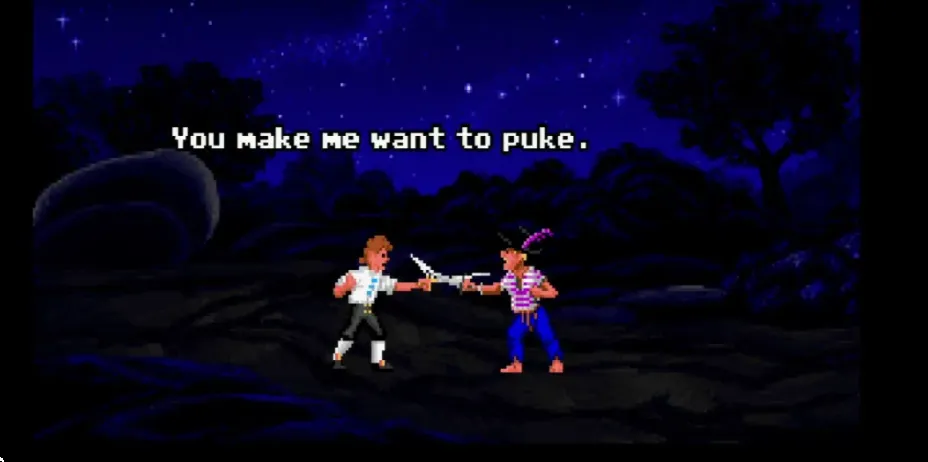

MONKEY ISLAND 2: LECHUCK’S REVENGE
The second game, Monkey Island 2: LeChuck’s Revenge from 1991, was available on fewer platforms; it was only released for PC MS-DOS, Amiga, Macintosh and later for FM Towns. As Guybrush, with a treasure chest in hand, and Elaine cling to the ropes in the void, he tells her the story of the game. You have decided to find the greatest of all treasures, the Big Whoop. Inadvertently, he helps revive LeChuck, who is now in zombie form. Guybrush is eventually captured by his nemesis, but escapes with the help of Wally and finds the treasure only to find himself hanging from a rope, as shown at the beginning of the game. The surreal ending is open to a number of interpretations.
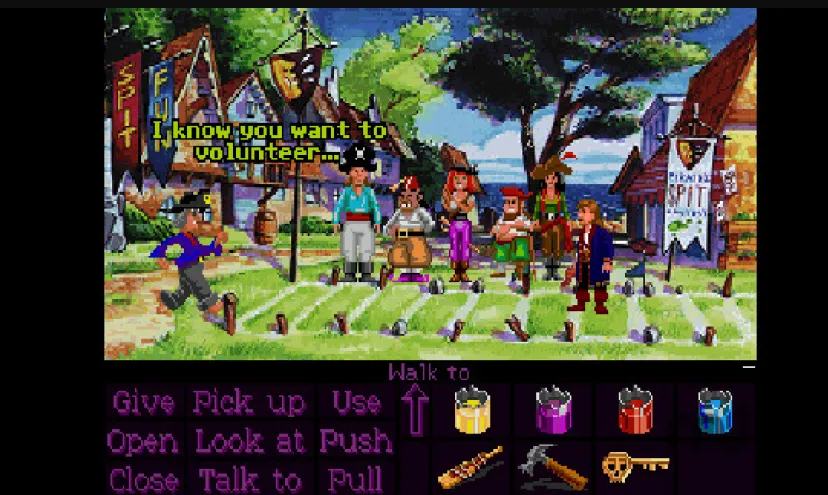

THE CURSE OF MONKEY ISLAND
The third in the series, it was exclusively available for Windows PC in 1997 after a 6-year hiatus in CDROM format. The footage from the third installment was also a preview of the old game, using a cel animation style. The Curse of Monkey Island is the only game in the series to feature this style of animation.
Guybrush inadvertently turns Elaine into a golden statue with a cursed ring, and the pirates soon steal her. He searches for her before looking for a ring that can lift the curse. LeChuck appears in a fiery demon form, and follows Guybrush's footsteps to a standstill at Monkey Mountain, LeChuck's amusement park.
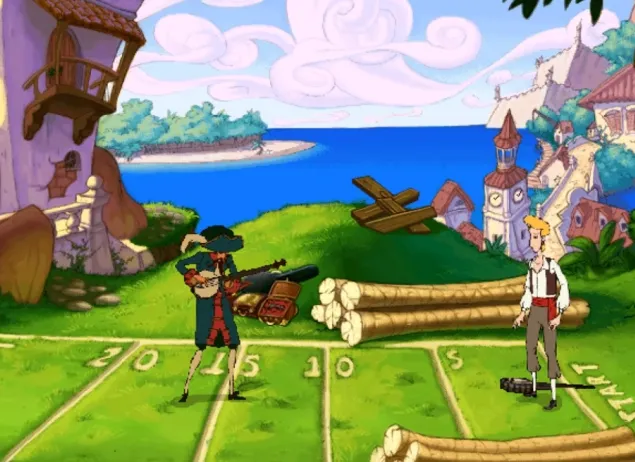

ESCAPE FROM MONKEY ISLAND
The fourth installment was released in 2000 for Windows PC and in 2001 for Macintosh and PlayStation 2. When Guybrush Threepwood and Elaine Marley return from their honeymoon, they discover that Elaine has been officially declared dead, her mansion is under order of destruction. and her position as governor is up for choice. Guybrush investigates and uncovers a conspiracy by LeChuck and the evil real estate developer Ozzie Mandrill to use a voodoo talisman, "The Ultimate Insult," to make all pirates docile and turn the Caribbean into a hub of tourism.
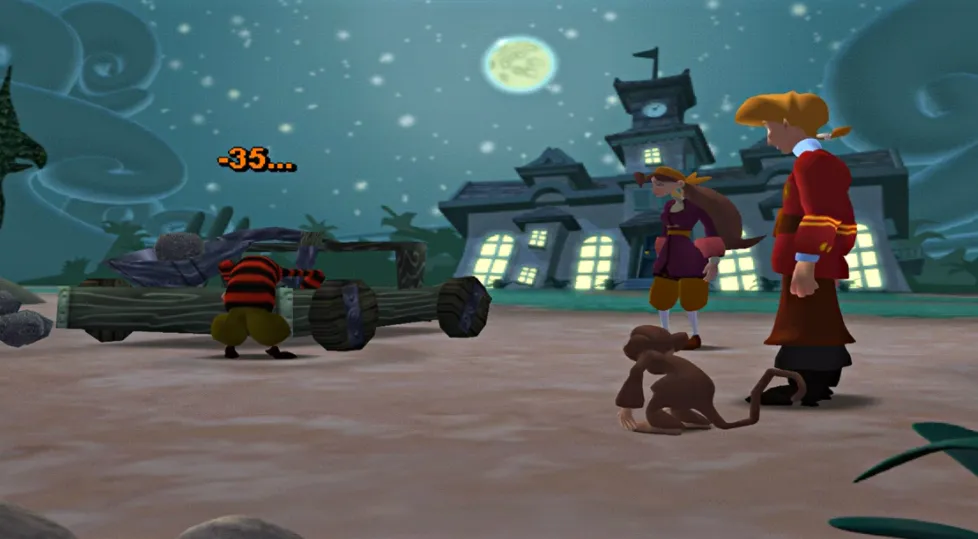

TALES OF MONKEY ISLAND
It is the fifth installment in the series, jointly developed by Telltale Games and LucasArts, with a simultaneous release on both WiiWare and PC and a year later on PSNetwork for PS3. Unlike other installments, Tales is an episodic adventure consisting of five different episodes. The first episode was released on July 7, and the last one was released on December 8, 2009.
During a heated battle with his nemesis, the evil pirate LeChuck, Guybrush unwittingly unleashes an insidious smallpox that is rapidly spreading throughout the Caribbean, turning pirates into zombie monsters. The voodoo lady sends Guybrush in search of a legendary sea sponge to stop the epidemic, but this seemingly straightforward search has surprises around every corner.
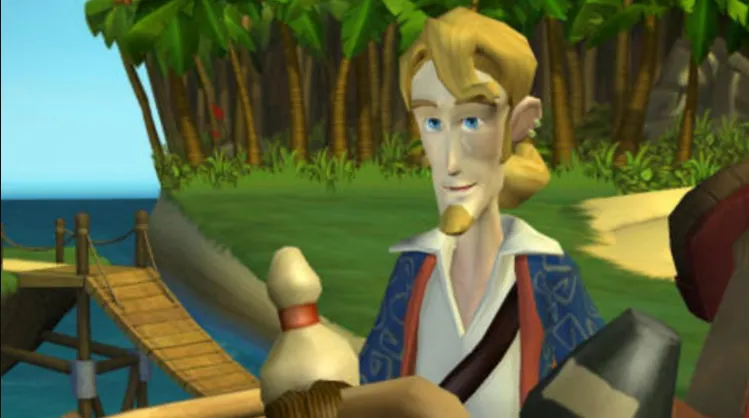

MONKEY ISLAND: SPECIAL EDITION
In 2009 a remastered version of the first two Monkey Island installments was released. This compilation featured a new, more current hand-drawn graphic style. Orchestral remastered soundtrack, voices throughout the game using actors from the original franchise to bring the story and characters to life like never before. Instant scene-to-scene switching that allows you to switch from new mode to classic mode at any time. As novelties it provided a new interface and controls and an integrated track system. It was released for PlayStation Network, Windows PC, Xbox Live Arcade, and OS X.
